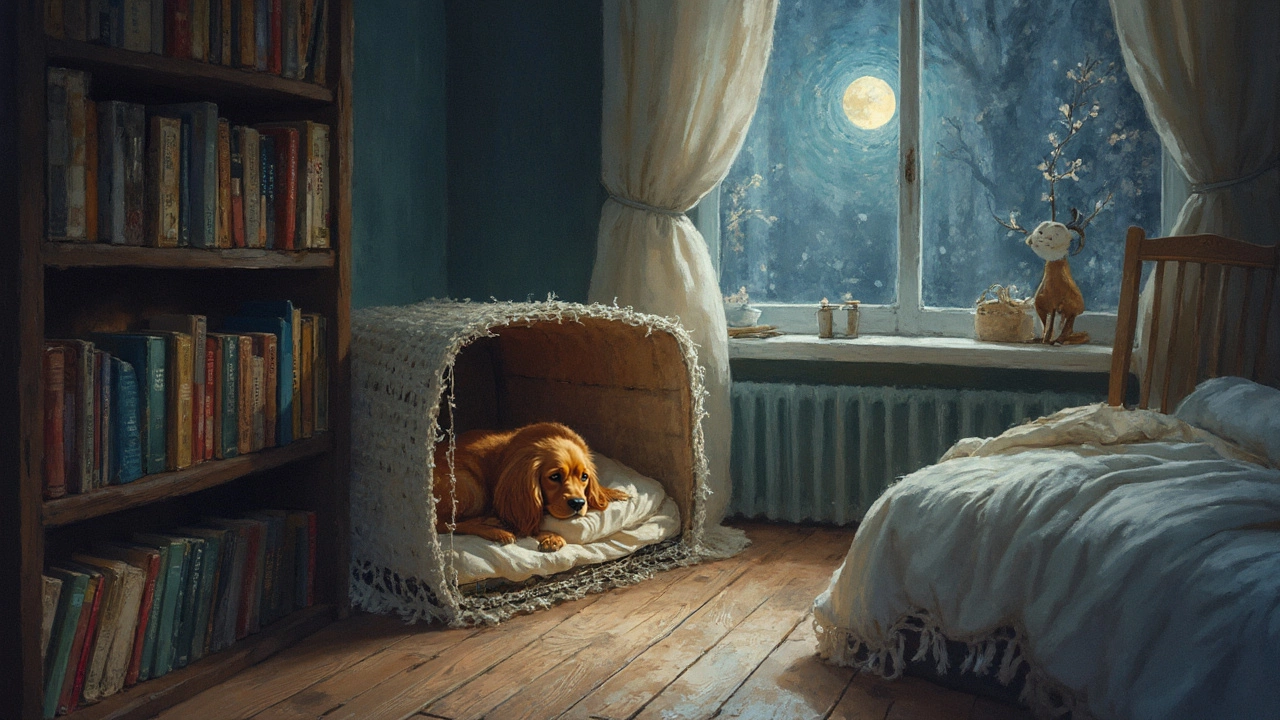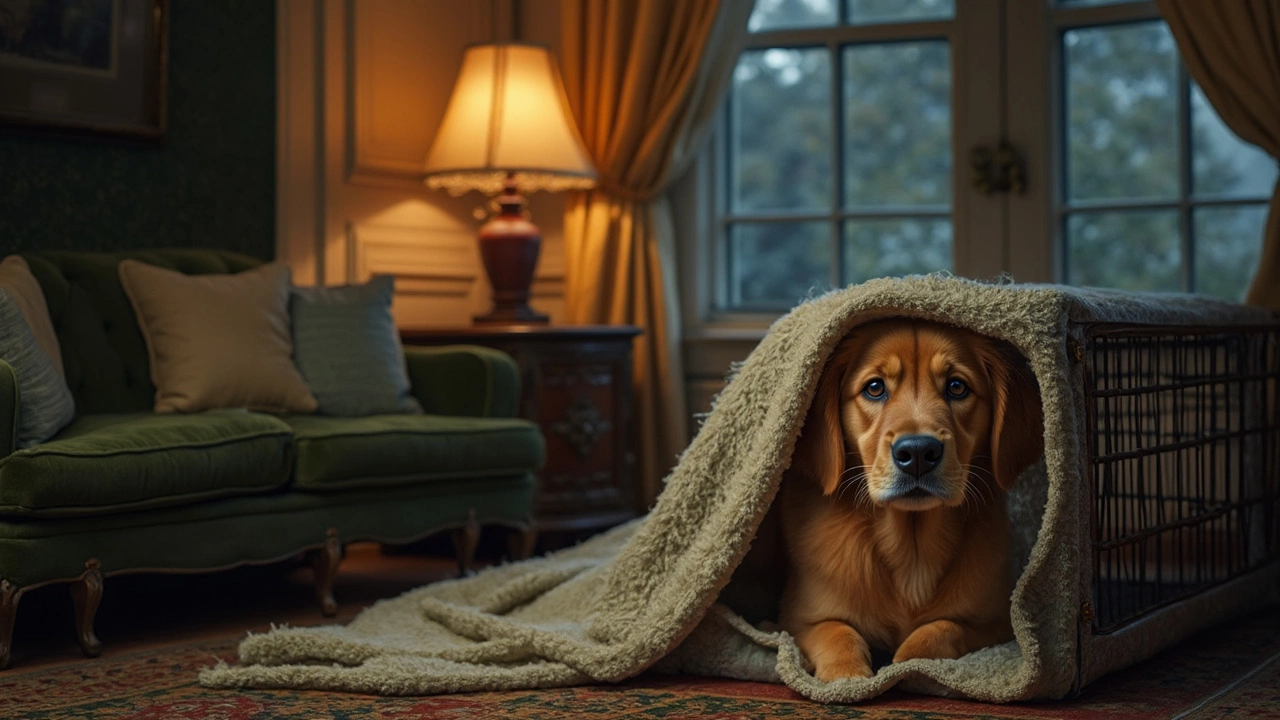If you're new to puppy parenting, one question might bug you a bit: should I cover my puppy's crate at night? There are solid reasons both for and against it, and the answer usually isn't one-size-fits-all.
Covering a crate can create a cave-like atmosphere, giving puppies a sense of security and helping them settle down more easily. Puppies, much like babies, find comfort in a cozy and dark space, especially when trying to sleep. But are there times when a cover might not be a great idea?
Well, if your puppy has a history of anxiety or if you notice they're often scared or unsettled, covering the crate might have the opposite effect. And of course, you want to make sure there's still airflow. A breathable cover or a lightly draped blanket can do the trick.
For those ready to give it a go, start by covering the crate during the day for short periods. This helps your puppy associate the covered crate with safety, not just nighttime. Keep an eye on their reaction; it's a learning experience for both of you!
- Why Consider Covering the Crate?
- Puppies and Their Need for Security
- When to Avoid Using a Crate Cover
- Choosing the Right Type of Cover
- Tips for Introducing a Crate Cover
- Signs Your Puppy Is Comfortable
Why Consider Covering the Crate?
Covering a puppy's crate at night is a bit like pulling the shades down in a cozy bedroom. It can transform the crate into a comfy, snug hideaway, shielding your little friend from distractions and encouraging a sense of security.
One big reason for using a cover is to help establish a routine. At night, the cover signals to your puppy that it's time to wind down, making it easier for them to adjust to nighttime sleeping patterns. Many puppies, who are naturally den animals, find solace in darker environments as it mimics a safe and quiet den.
The Emotional Comfort
Using a cover can buffer your puppy from visual stimulation that might otherwise keep them awake. If you live in a busy household or an area where street lights filter into your home, a covered crate can help minimize these distractions.
According to a small survey of pet owners, around 60% mentioned that their puppies calmed down significantly when tucked into their covered crates. This was particularly true in the initial stages of crate training when everything felt new and overwhelming.
Temperature Control
An added benefit is managing the crate's internal climate. While a crate cover shouldn’t seal off the space (because airflow is crucial), it can help keep warmth in during cold seasons or help block drafts. On the flip side, in warmer temperatures, it's important to ensure the crate isn’t overheating.
- Use a breathable material to prevent overheating.
- Avoid covering the entire crate and leave space for ventilation.
Finally, keep an eye on how your puppy responds. If covering the crate seems to make them more anxious or restless, consider uncovering or partially uncovering until they seem more at ease. Like anything about puppy care, it’s about finding what works best for your furry buddy.
Puppies and Their Need for Security
Puppies, like many young creatures, crave a sense of security as they explore the world. Just think about how a baby gets comfort from being swaddled. For puppies, their version of a snug wrap can be a crate. Crates can offer a safe retreat that feels like a cozy den.
So, why is this feeling of security important? Well, when puppies feel secure, they are less likely to be anxious and can actually learn quicker. A stressed puppy might bark, whine, or have trouble settling down. On the flip side, when they feel safe, they're calmer and more likely to take on new training cues. It sets a foundation for becoming well-adjusted adult dogs.
The Role of a Crate Cover
You might ask, how does covering a crate support this security? The cover can help block out distractions, reducing overstimulation and helping a puppy feel more relaxed. It's like drawing the curtains in a bustling room to make it less chaotic. But remember, it's all about balance. The crate needs to remain inviting and not feel like a shut-off space.
Signs Your Puppy Feels Secure
- They willingly go into the crate without any urging.
- Your puppy settles quickly once inside the crate.
- Calm behavior without frequent barking or whining.
- Curiosity rather than fear when introduced to new things.
For many new pet parents, understanding these signs helps in figuring out if their puppy care approach is working. Taking note of a puppy's body language can tell you a lot about how they're feeling.
When to Avoid Using a Crate Cover
There are definitely times when covering your puppy's crate might not be the best idea. Let’s dive into what those moments look like.
Anxious Puppies
If your puppy tends to get anxious or shows signs of stress when confined, a crate cover might add to their anxiety. Puppies who aren't yet fully crate trained sometimes need to see their surroundings to feel secure. In such cases, removing the cover could help minimize stress.
Insufficient Airflow
Puppies, like all living beings, need proper ventilation. If the crate cover results in stuffiness or feels like it's straight out of a hot summer day, it's best to skip it. Opting for breathable fabrics or leaving parts of the crate uncovered can help maintain proper air circulation.
Temperature Issues
Besides airflow, consider the room’s temperature. Puppies can overheat quickly, and covering the crate might make it too warm, especially in the summer. Keep an eye on their comfort – if you’re sweating, they might be too!
Monitoring Health and Safety
If your puppy is feeling under the weather, you'll want to have a clear view of them at all times. Adding a cover might obstruct your ability to monitor them and quickly respond if they need attention.
Experiment and Adjust
The key here is flexibility. Try different approaches and see how your puppy reacts. If your pup's uncomfortable, simply adjust until you find what works best. Remember, every puppy is unique, and observing their reaction is crucial for puppy care success.

Choosing the Right Type of Cover
So you're thinking about covering your puppy's crate? Picking the right cover is kind of a big deal, and there are a few things to keep in mind to make the best choice for your little buddy.
Material Matters
The first thing you want to consider is the material. A breathable fabric is key here. You don't want anything that traps heat or restricts airflow. Look for covers made from cotton or lightweight polyester, which let air pass through while creating a cozy nook.
Custom-Fit vs. DIY
Should you buy a custom-fit cover or just use a spare blanket? Well, a custom-fit cover might cost more, but it's designed to fit snugly on the crate without draping onto the floor where your puppy might chew it. On the flip side, a simple blanket can do the job too if secured properly. Just make sure it's securely attached and not a tripping hazard.
Additional Features
- Flexibility: Some covers come with roll-up panels, letting you adjust how much light and air get in.
- Machine Washable: Puppies can be messy, so a cover that's easy to wash will save you some headaches.
- Design: Okay, this is more about you than the puppy, but if you can find a cover that doesn't clash with your living room décor, why not?
Here's a quick breakdown of some popular cover features:
| Feature | Benefit |
|---|---|
| Breathable Fabric | Prevents overheating and maintains airflow |
| Custom-Fit Design | Reduces risk of chewing and ensures snug fit |
| Machine Washable | Easy to clean and maintain |
Choosing the right cover can make a world of difference in how well your puppy adapts to crate training. Give it some thought and see what fits best for both your home and your puppy's comfort.
Tips for Introducing a Crate Cover
Ready to make the nighttime transition smoother for your pup? Introducing a crate cover might be the trick you've been looking for. Here are some straightforward steps to ensure your puppy adjusts comfortably.
Start Slowly and Observe
Initially, cover just a portion of the crate, maybe just the top. This allows your puppy to get used to the idea of a covered space without feeling boxed in. Keep an eye on their reaction during the first few nights. Are they settling quicker, or does it seem to stress them out? Every pup is different, so watch and adjust as needed.
Ensure Proper Ventilation
While you're looking for that cozy den feel, it’s crucial to keep things breathable. Puppies need proper airflow to nap comfortably. Opt for a light blanket or a specially designed puppy crate cover that's made from breathable fabric. You can also leave one or more sides uncovered, particularly if the room temperature gets a bit warm.
Use the Cover During Daytime
Believe it or not, daytime is an excellent opportunity to incorporate the cover. Cover the puppy crate for short intervals when your pup is chilling inside, not only for nap time. This repetition will help your pet associate the cover with safety and relaxation, rather than just for sleepy time.
Consider Your Pup's Unique Needs
Some puppies might instinctively nestle into the covered crate, feeling secure in their 'den.' Others may interpret it as a strange and confining change. It’s worthwhile to pay attention to individual behavior. For puppies with vision impairments or higher anxiety levels, extra patience and care might be required.
Gradual Covering Plan
If the complete cover is your end goal, consider using a gradual approach.
- Start with partial coverage for the first few days.
- Increase the coverage day by day if your puppy seems comfortable.
- Observe your pup’s behavior closely during the process, dialing it back if they seem uneasy or anxious.
This way, you're allowing plenty of time for your puppy to adjust and not rushing the process.
Signs Your Puppy Is Comfortable
When you've got your puppy's crate game on point, there are some tells that your little buddy is comfy and happy. So how do you know if covering the crate is helping? Let's dig into it.
Relaxed Body Language
If your puppy is stretching out or cozying up with their favorite toy, they're probably at ease. No tense muscles or frantic pacing back and forth. Just pure, chill contentment.
Easy Breathing
Check how they're breathing. Comfortable puppies have steady and slow breathing patterns when they're in their crate. Heavy panting or whining might mean they're stressed or uncomfortable.
Quiet Time
A happy puppy isn't a noisy puppy. If your crate-covered pup snoozes soundly and only barks when necessary, like for a late-night bathroom break, they’re likely pretty satisfied with their sleeping arrangement.
Entering the Crate Willingly
Notice if your puppy goes into the crate without much fuss. If covering the crate makes them feel secure, they won't hesitate to trot in. Believe it or not, some puppies even treat their crates like a mini fort.
Comfortable Transition After a Change
If you recently changed the crate environment and your puppy adjusts quickly, it's a good sign. A seamless switch from an uncovered to a covered crate without signs of distress means they're good with the change.
So, there you go. If your puppy ticks most of these boxes, those nighttime crate cover dramas might just be behind you!
